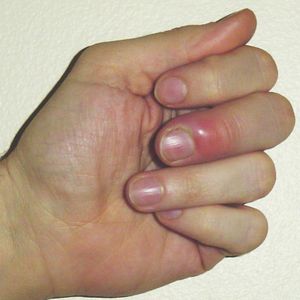We need you! Join our contributor community and become a WikEM editor through our open and transparent promotion process.
Paronychia
From WikEM
Contents
Background
- Inflammation/infection of the proximal or lateral nail folds[1]
- Usually caused by direct or indirect minor trauma (e.g. nail-biting, manicures, hangnails, ingrown nail, dishwashing)
- Trauma allows entry of bacteria
- S. aureus is most common, although S. pyogenes, Pseudomonas pyocyanea, and Proteus vulgaris are also common[1]
Clinical Features
- Rapid onset of erythema, edema, and pain of proximal or lateral nail folds[1]
- Usually only affects one nail
- May see purulent drainage (expressed with pressure on nail)
Differential Diagnosis
Hand and finger infections
- Bedbugs
- Closed fist infection (Fight Bite)
- Hand cellulitis
- Hand deep space infection
- Herpetic whitlow
- Felon
- Flexor tenosynovitis
- Paronychia
- Scabies
- Sporotrichosis
Evaluation
- Clinical diagnosis, based on history of minor trauma and physical examination
- If unclear if wound is fluctuant:
- Have patient apply pressure to distal aspect of affected digit
- A larger than expected area of blanching, reflecting a collection of pus, may identify need for drainage
Management
Acute
- More likely to be bacterial
- If no fluctuance is identified:
- Warm compresses, soaks, elevation
- Antibiotic ointment TID x5-10 days (mild cases) ± topical steroid
- PO Antibiotics (more severe or persistent cases)[1]
- Augmentin BID x7 days OR
- Clindamycin 150-450mg TID or QID x7 days OR
- TMP-SMX DS 1-2 tab PO BID x7 days
- If fluctuance or purulence is identified:
- Consider soaking hand for preparation
- Consider digital block
- Incise area of greatest fluctuance
- Incise parallel to nail (do NOT incise perpendicular to fluctulance)
- Use iris scissors, flat tweezers, or #11 blade
Chronic
- Multifactorial inflammation due to persistent irritation - may also have fungal component[1]
- Mainstay of therapy is avoidance of irritant
- Consider topical antifungals vs Diflucan 150mg po qweek x 4-6 weeks
Disposition
- Discharge

